Overview of harmful algal blooms (red tides) in Hong Kong during 1975–2021
Kin Chung HO
1 Department of Geography, University of Hong Kong, Hong Kong Special Administrative Region, Hong Kong 999077, China
2 College of Marine Ecology and Environment, Shanghai Ocean University, Shanghai 201306, China
Abstract Hong Kong has a long historical record of harmful algal blooms (HABs). In the 1980s–1990s,HABs were mainly pollution-related and most of the events happened in estuaries and enclosed embayment such as Tolo Harbour and Port Shelter. The major cause of HABs in 1980s–1990s was closely related to nutrients enrichment; included but not limited to changes in the concentration and ratio of soluble N and P in seawater. The major causative organisms of HABs in Hong Kong by then were meso-plankton such as selected species of diatoms and dinof lagellates. Sometimes, zooplankton was also a cause of red tides (the common name of HABs). There has been gradual change after the 2000s. It is attributed to higher and higher inf luences from the region, namely the Zhujiang (Pearl) River delta. There are increasing inf luences from Chinese mainland due to extraordinary social and economic growths during the past 20 years. In the past 10 years, HABs in Hong Kong was mainly subject to regional impacts in the Zhujiang River delta. Both the duration period and covered areas have been enlarged which overwhelmed the localized inf luences of stream pollution and self-contamination of aquaculture zones. More f lagellates of uncommon happening become dominant species in HAB now. Nevertheless, the seasonal impact of Noctiluca scintillans in late winter to mid spring remained.
Keyword: harmful algal blooms (HABs); Tolo Harbour; long-term trend; regional eutrophication and environmental impacts
1 INTRODUCTION
Hong Kong is located in South China near the Zhujiang (Pearl) River estuary (Fig.1). The Special Administrative Region of China has a long historical record of harmful algal blooms (HAB, commonly known as red tides). Ho and Hodgkiss (1991) reviewed red tide occurrences in subtropical waters including Hong Kong from 1828 to 1989. They showed that red tides had been reported in more than 19 countries in the subtropical region, with the majority occurring in the Western Pacif ic Ocean. Hong Kong, like others in the coastal areas of South China Sea, had exponential increase in the number of HAB incidents from the 1950s to 1980s. In that period, increase of red tides in Hong Kong is was closely relevant to eutrophication which is an outcome of rapid social and economic developments and discharges of polluting matters into received waters (Holmes and Lam, 1985; Lam and Ho, 1989a; Wong, 1989; Lam and Yip, 1990). Nevertheless, red tide, which was the name commonly used in previous literature and governmental document of Hong Kong, was mainly related to occasional incidents of harmful algal blooms caused by localized discharges of sewage (~60%),agricultural wastes (~30%) and industrial pollutants(~10%) in enclosed embayment such as Tolo Harbour,Port Shelter and Junk Bay (Lam and Ho, 1989b; Ho and Hodgkiss, 1993a, 1995a, b; Liu et al., 2000; Li et al., 2004). Various f ield and laboratory studies showed that HAB organisms favor for a special range of N꞉P ratio whereas the triggering concentration of inorganic Nitrate-nitrogen, Ammonia-nitrogen and soluble Phosphates are mainly responsible (Ho and Hodgkiss, 1993b; Huang et al., 1994; Hodgkiss and Ho, 1997; Yin et al., 2000; Hodgkiss, 2002). Tseng et al. (1993) recorded 11 toxic species to be existed in Hong Kong waters. It is however found that >90%of red tide occurred in that period were not relevant to toxic algal species (Red Tide Information Network of the Hong Kong—an online information system developed and managed by the Agriculture, Fisheries and Conservation Department of Hong Kong Special Administrative Region, China (AFCD); Liu et al.,2000; Yung et al., 2001; EPD, 2006). The major economic loss of HAB in Hong Kong, as documented,was relevant to f ishkills, which was resulted from the anoxic status in water bodies due to rapid growth of micro-algae that consumes most of the dissolved oxygen at night time (Wong, 1989; Anderson, 1999;Anderson et al., 1999; Li et al., 2004; EPD, 2006).For example, the HAB in the spring period of 1998 at Hong Kong and nearby areas had resulted with huge amount of f ishkills in aqua-cultural zones (Lu and Hodgkiss, 1999a). The economic loss for an incident caused byKareniadigitatawas greater than 40 million US dollars (Lu and Hodgkiss, 2004).
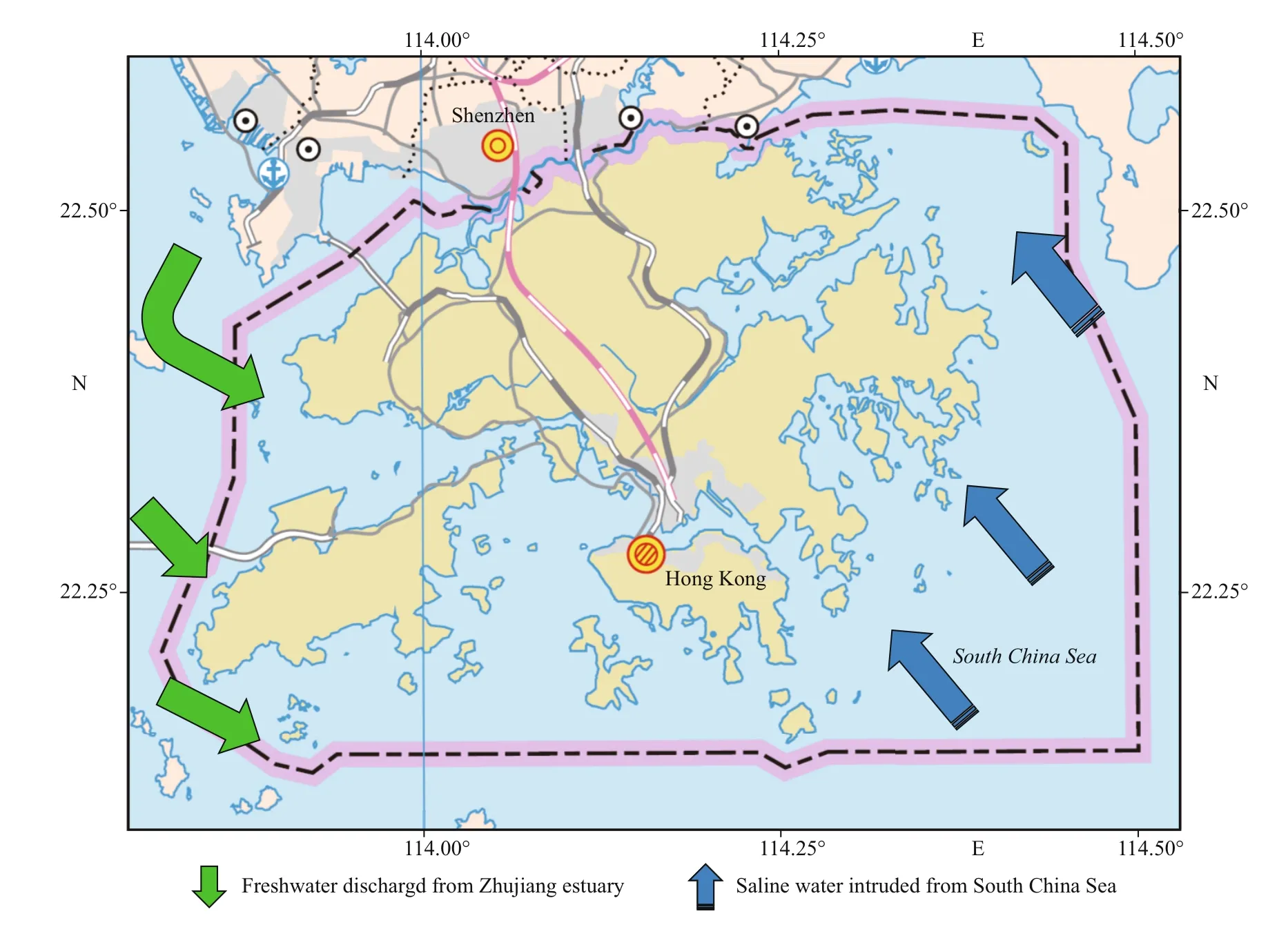
Fig.1 Location of Hong Kong showing the hydrographic situations
While statistical data of HAB events in Hong Kong during the 1970s–1990s and relevant particulars of biological and environmental situations were widely discussed (Morton and Twentyman, 1971; Hodgkiss and Chan, 1987; Lam and Ho, 1989b; Qi et al., 1995;Yung et al., 1997, 1999, 2001; Yang and Hodgkiss,2004), relatively little amount of updated information has been published in academic journals after 2005.Therefore, this paper aims to overview the situations in Hong Kong relevant to HAB from 1975–2021.Special features are highlighted for future studies of formation mechanism, control strategies and new developments of management of HAB can be elucidated. The trends of HAB in Hong Kong are analyzed to elucidate inf luences generated by recent social and economic developments of China which is playing increasing leading-roles in environmental sustainability of contemporary society.
2 MATERIAL AND METHOD
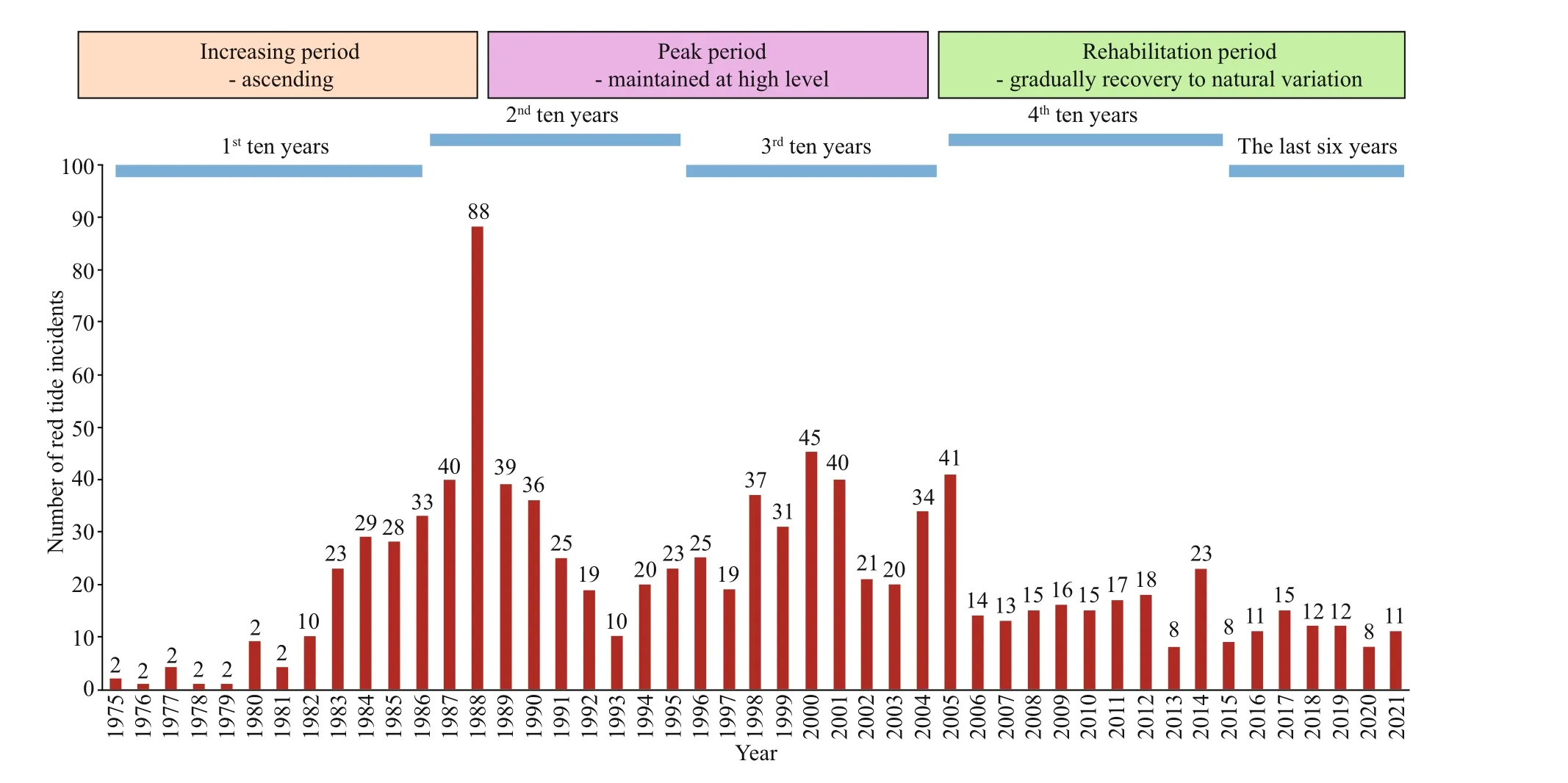
Fig.2 Yearly number of red tide incidents in Hong Kong during 1975–2021
This is a paper on the basis of review of past documents, published papers and online data available from the websites of government. Certain data for analysis and discussion are extracted from the various annual marine water quality monitoring reports of Hong Kong published by the Environmental Protection Department of Hong Kong (EPD). Moreover, macroscopic information such as annual trend, averaged monthly patterns and causative species, and relevant original diagrams,were downloaded from the Red Tide Information Network of the Agriculture, Fisheries and Conservation Department of Hong Kong (AFCD).Acknowledgments are attributed to the Government of Hong Kong Special Administrative Region, China for the generosity of using relevant original data for secondary analyses. Other background information and data used in this paper are generally cited from published references as listed at the end of this paper.
3 RESULT
3.1 Annual variation
From 1975 to 2021, there were 983 incidents of red tide offi cially recorded by the Government(AFCD, updated Mar. 2022). It is noted that most of the incidents (360 incidents, 36.62%) occurred during the decade from 1983 to 1992, while 281 (28.58%)incidents happened during the decade from 1994 to 2003 (Fig.2). The number of incidents totaled 726 incidents (73.85%) from 1983 to 2005, representing that Hong Kong waters were severely aff ected by HAB during that period. Yet, the incidents gradually decreased to less than 23 incidents per year after 2005 which is closed to the natural variations before the 1980s. There were only 140 (14.24%) incidents occurred during the decade 2010–2019, with contrast to the high percentage in earlier decades. From 2015–2021, there was 78 incidents (7.93%) of red tide offi cially recorded, with an annual average of 11.14 incidents. As compared to the peak periods of red tides in 1980s, 1990s, and 2000s, when the annual average is 31.57 and when is considered to be badly associated with eutrophication in local waters, the marine environment of Hong Kong is shown to be gradually ecologically rehabilitated.After careful observation, it is found that the time schedule of HAB in Hong Kong can be divided into three diff erent stages: (1) the “Increasing Period”which covers the years of 1975–1983; (2) the “Peak Period” which covers the years from 1984 to 2005;(3) the “Rehabilitation Period” which covers the years after 2006 (up to the date of writing this paper). The general improvement of water quality is attributed to continuous enhancement of environmental measures including but not limited to the enactment and implementation of the Water Pollution Control Ordinance of Hong Kong (cap. 358), enhancement of management of the various f ish culture zones that avoid unnecessary self-contamination and installation of environmental infrastructures such as sewerage and sewage treatment plants (EPD, 2006, 2021).
3.2 Monthly pattern
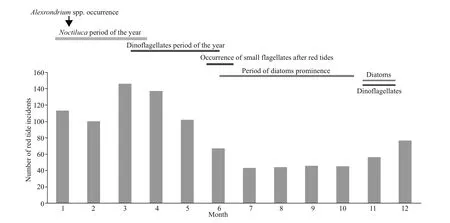
Fig.3 Monthly variation of red tide occurrence in Hong Kong, updated 2021 (after the Red tide Information Network of Hong Kong) (bars); seasonal occurrence of diff erent prominent HAB species in Hong Kong with respect to diff erent months of a year (lines)
As shown in Fig.3, late winter (late January) to early summer (May–June) is the peak period of red tide occurrence in Hong Kong (Fig.3). During July to early October, the number of red tide incidents becomes relatively small and stable. It is believed to be associated with the relatively high temperature in seawater (27–32 °C) during hot summer of the subtropical climate. In the months of July, August and early September, vertical water exchange along the depth prof ile is limited that restricts and reduces the replenishment of sediment-locked nutrients (e.g.,total inorganic nitrogen and soluble phosphate) to the surface layer (Holmes and Lam, 1985; Hodgkiss and Chan, 1987; Lam and Ho, 1989b; Ho and Hodgkiss,1991; Liu et al., 2000; Yin, 2003). Algal growth is therefore greatly aff ected by the supply of suspended and soluble nutrients that support crop yield (Lam and Ho, 1989b; Ho and Hodgkiss, 1995a, b; Yung et al., 1997). Moreover, the relatively high seawater temperature, lower salinity and correspondent N꞉P ratio changes are shown to be unfavorable for the growth of some dinof lagellates species which is the major group of causative organisms of HAB (Ho and Hodgkiss, 1995a, b; Huang, 1995; Yin et al.,2000). Yet, the number of red tide incidents gradually increases in the autumn period of Hong Kong and gradually resumes to a situation of higher risk to HAB occurrence during December to early January.
It is noteworthy that the blooms ofNoctilucascintillanshappen regularly in late winter to mid spring (Yung et al., 1998, 1999; Yin et al., 2000; Liu et al., 2000; Lu and Hodgkiss, 2004). They change seawater color into orange or pink, which is very obvious and attractive to media reports and attention of the general public. Sometimes,Alexandriumspp.appear in water samples although paralytic shellf ish poisoning (PSP) intoxication event rarely happened in Hong Kong (Ho and Hodgkiss, 1993b).
3.3 Major causative organism
Diatoms is traditionally the most dominant group of planktonic organisms in the surface layers of seawater in Hong Kong (Hodgkiss and Chan, 1987; Lam and Ho, 1989b; Yung et al., 1997; Liu et al., 2000; Yung et al., 2001; EPD, 2006, EPD—Water Quality Resources Centre of HKSAR). According to the annual water quality monitoring results, a total of 97 phytoplankton species were recorded in Hong Kong waters during the regular phytoplankton monitoring program of EPD in 2020. Out of them, 56 species (58%) were diatom, 27 species (28%) were dinof lagellate and 14 species (14%) were organisms belonged to 7 groups of other minor algae and f lagellates.
Out of the diatoms,Bacillariaspp.,Chaetocerosspp.,Coscinodiscusspp.;Fragilariaspp.,Leptocylindrusspp.,Naviculaspp.,Nitzchiaspp.,Pseudonitzchiaspp.,Skeletonemacostatum, andThalassiosiraspp. are the frequently identif ied phytoplankton in the regular water quality monitoring programme (Law, 2019). The major dinof lagellate genera includes (but not limited to) are:Alexandriumspp.,Ceratiumspp.,Exuviellaspp.,Gymnodiniumspp.,Gonyaulaxspp.,Noctilucaspp.,Peridiniumspp.,Prorocentrumspp.,Pyrodiniumspp., andScrippsiellaspp. (Red Tide Information Network of Hong Kong).
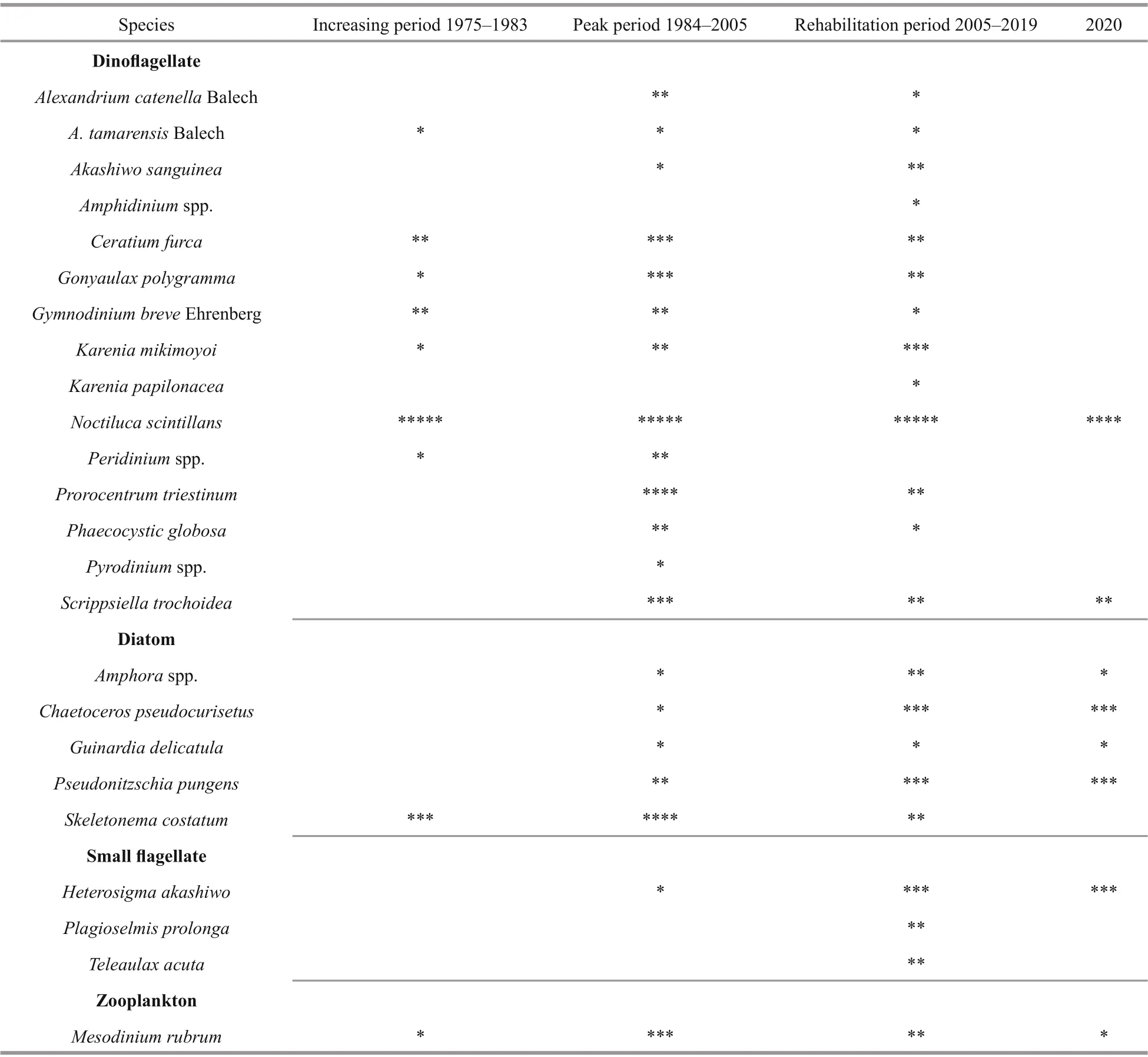
Table 1 Causative organisms of HAB in Hong Kong during 1975–2021: a summary of the research records of the author for the past 40 years
Diatoms (Table 1) were also reported to be the dominant group of phytoplankton in terms of cell density. For examples,Chaetocerosspp. constituted 8% to 47% of the diatom population in all Water Control Zones of Hong Kong (EPD, 2021). With contrast, the most abundant dinof lagellate genus wereGymnodiniumspp. in 2019–2020. It comprised 39% to 75% of the total dinof lagellate population as observed in the Western Water Control Zone,Southern Water Control Zone, Tolo Harbour and Channel Water Control Zone and the Port Shelter Water Control Zone. Due to localized eutrophication impacts, the phytoplankton densities in the inner Tolo Harbour was still the highest in Hong Kong although the number of red tide incidents as recorded there is in a decreasing trend.
Often, blooms of certain diatoms species also generates discoloration of seawater. Therefore, high cell-density ofSkeletonemacostatum,Nitzchiaspp.,Thalassiosiraspp., etc. in the summer time was often counted as “red tide incidents”, which are reported and disseminated in the Red Tide Information Network of the government.
As discussed in previous sections and Fig.3, the prominent HAB causative species in late winter to mid spring isNoctilucascintillans. The density ofNoctilucascintillansin seawater samples peaked from January to April. Its appearance is believed to be associated with intrusion of oceanic current from the South China of that the Kuroshio carries the vegetative cells from north to south across the South China Sea. The vegetative cells ofNoctilucascintillansf inally reaches the coast of Vietnam in April to May (Ho et al., 2018). Generally, winter is the season when freshwater input from the western coast of Hong Kong (near Zhujiang River estuary)is weak (Morton and Twentyman, 1971). During the same period, oceanic water of relatively high salinity and lower temperature intrudes the eastern and southern coasts of Hong Kong. The environmental situations by that period bring favorable support to the growth of vegetative cells ofNoctilucascintillans.The rapid growth of theNoctilucascintillanscells is enhanced by the nutrients-enriched water at inshore environment. The bio-f lorescent power of massive amount ofNoctilucascintillanscells during the night hours, commonly known as “the blue tears” by poets and news reporters.
The HAB incident ofNoctilucascintillasis often replaced by the blooming of other dinof lagellates,including but not limited toProrocentrumspp.,Ceratiumspp.,Gonyaulaxspp.,Gymnodiniumspp.,andScrippsiellaspp. Since Tolo Harbour and Port Shelter are of very short distance from Daipeng Bay of Shenzhen, HAB events in the western side of Shenzhen is closely associated with incidents reported by f ishermen in Sha Tau Kwok, Kat O Island, Tolo Channel, and other eastern waters of Hong Kong.
Kareniaspp. is reported favors for relatively high total inorganic nitrogen (TIN) and soluble P supplies(Kwok et al., 2016). Small f lagellates and other planktonic species, includingMesodiniumrubrumwhich is a zooplankton species, frequently take over the dominance in phytoplankton community after HAB event, and generate the secondary ecological impacts and another HAB. These f lagellates normally take the metabolites released from the death cells of micro-algae as nutrient.
When hot summer come, diatom who is able to tolerate higher seawater temperature and oligotrophic level would take over the dominance of phytoplankton community. The periodic changes of phytoplankton community in diff erent months of a year is considered the seasonal norm of marine ecosystem in subtropical environment including Hong Kong. The availability of nutrients particularly N and P, and a specif ic N꞉P ratio, are closely associated with HAB aggregation and dissipation (Ho and Hodgkiss, 1991). In addition,Hodgkiss and Ho (1997), Ho and Hodgkiss (1995a)and Yin (2003) found that levels of at silicates (Si)in seawater also attributes to HAB occurrence. In summary, the variations of N:P:Si ratios are important for stimulating, triggering and supporting the growth of HAB species in Hong Kong.
3.4 HAB-related toxicity
Red tide in Hong Kong is rarely associated with severe intoxication events (Red Tide Information Network of Hong Kong, updated March 2022;Lin et al., 1994). The biggest events that raised the attention of media reporters and academic interest are backdated to those happened in 1989 and 1991,when low concentration of PSP toxins were detected during food surveillance by government staff . The appearance of PSP toxins were suspected to be associated with certain amount ofAlexandriumspp.,which were detected in seawater samples (Lin et al.1994). The incident resulted in the closure of shellf ish market for 2 weeks (Ho and Hodgkiss, 1989). Yet,little report related to HAB-intoxication has been announced thereafter. During the past 10 years,only limited amount of red tide incidents are related to ‘toxic’ species such asHeterosigmaakashiwo,Pseudo-nitzschiapungens, andKareniabrevisulcata.Nevertheless, government offi cers have made full use of the Red Information Network to disclose information and give warning to f ishermen, relevant business sectors and governmental staff who look after food hygiene. In addition, the government has established up an internal management mechanism which involves the enthusiastic participation and cooperation of relevant government departments. For work at the advisory level, the Agriculture, Fisheries and Conservation Department (AFCD) sets up the Red Tide Experts Advisory Group which convenes meetings at regular intervals with members from diff erent tertiary institutions, professional bodies and business sector.
3.5 Nutrient level vs HAB occurrence
Nutrients are comprised of organic carbon,ammonia-nitrogen, total inorganic nitrogen (TIN),and soluble phosphates support the growth of harmful algae. Sometimes, they are also the triggering and limiting factors. Therefore, monitoring of water quality is fundamental for control, management and research of HAB. In Hong Kong, marine water quality monitoring is one of the major duties of theEnvironmental Protection Department (EPD), while the AFCD is the authority in handling matters related to f isheries particularly the aquaculture.
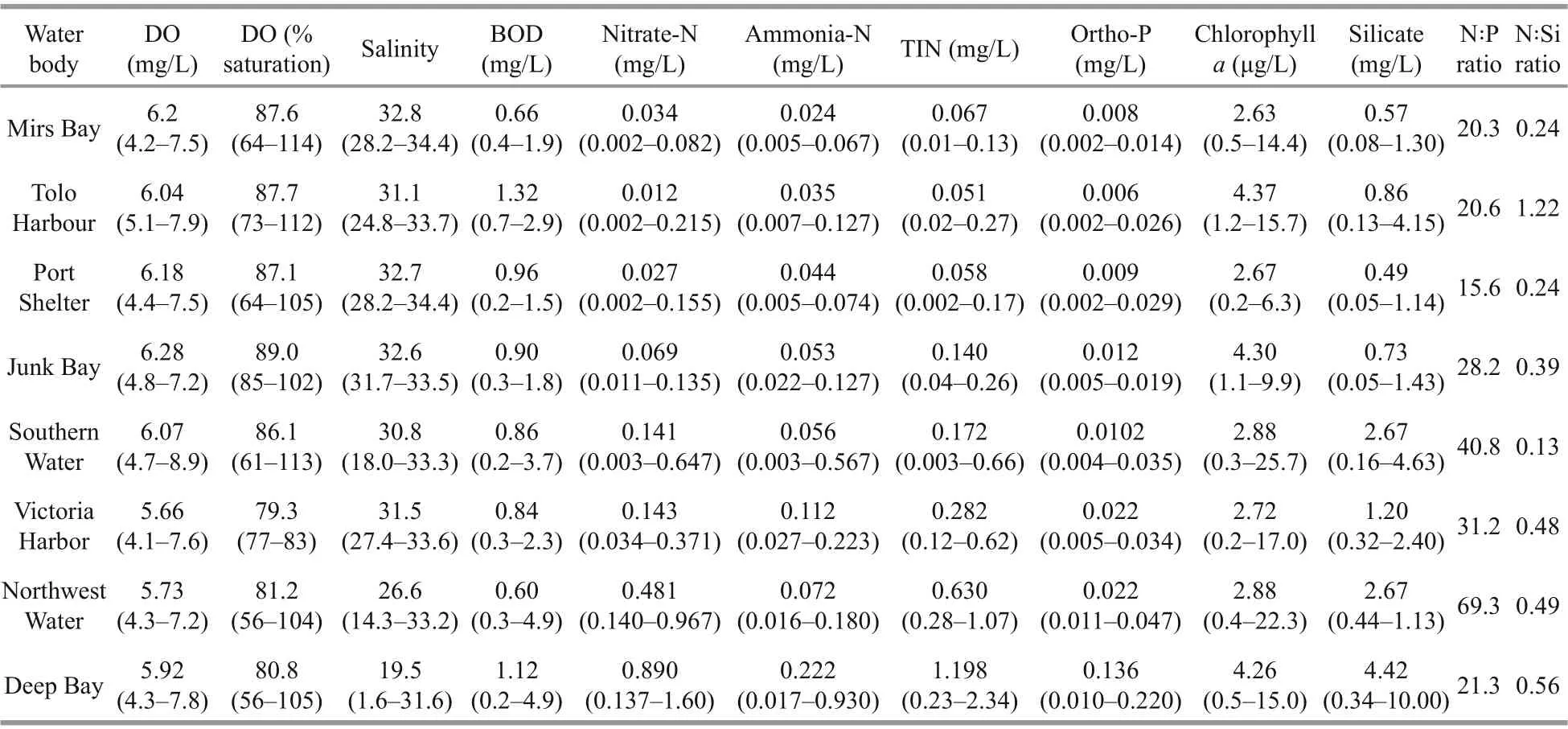
Table 2 Summary of water quality parameters in Hong Kong marine environment for 2020
As discussed above, marine water quality in Hong Kong is generally on an improving trend during the past 20 years. It was disclosed by the EPD that,under the perspectives of the Water Pollution Control Ordinance (cap. 358), the overall compliance of Water Quality Objectives (WQO) in Hong Kong had achieved a recorded high level of 86% with contrast to only achieving only 60% compliance in the late 1980s and ~75% in early 2000. It is encouraging to note that the compliance of WQO on ammonia-N has continuously achieved for six consecutive years since 2015. Moreover, the compliance rates of dissolved oxygen (DO) and total inorganic nitrogen (TIN) were 97% and 57% respectively in 2020. Unfortunately,various localized pollution sources, such the selfcontamination generated by f ish cultivation cages in Tolo Harbour, are still aff ecting the water quality which is relevant to HAB. Moreover, the poor dilution capability of inner Tolo Harbour still results with prolonged eutrophication and occasional blooms of harmful alga there.
Table 2 summarizes the variations of major water quality parameters in Hong Kong in 2020. As shown,the north-western coast and the southern waters of Hong Kong which are susceptible to inputs of polluting matters from the Zhujiang River estuary are most worrying. The high levels of BOD, ammonia-N,nitrate-N, TIN and orthophosphate there represent the adverse impacts of wide-area, non-pointed discharges from the catchment of the Zhujiang River.Recently, the state government is enthusiastically promoting the development of Guangdong-Hong Kong-Macau Greater Bay Areas into a major social and economic zone in China. With regard to HAB,the trend of estuarine eutrophication should not be overlooked as nutrients are the major triggering and supporting agents of HAB. The attempt and eff orts to reduce HAB incidents in the past years,for example. Implementing the Tolo Harbour Action Plan so that nitrogen and phosphate loading in the watershed could be signif icantly reduced, should not be subtracted by regional environmental impacts in a long run. It is noteworthy that the overall WQO compliance rate for Deep Bay (namely as Shenzhen Bay by the government of Chinese mainland) Water Control Zone was only 67%. In fact, it is encouraging to note that cross-jurisdiction collaboration has been actively and eff ectively implemented during the past decade. Therefore, as compared with the ten-year average of 47% compliance, the current improvement trend should be commended.
4 DISCUSSION
In the following section, with regard to HAB in Hong Kong, we would like to discuss with a more macroscopic eyesight and from the regional and global points of view.
4.1 Spatial change
The percentage distribution of HAB incidents invarious waters of Hong Kong as happened during the past 47 years are shown in Table 3. In the past,most HAB incidents happened in the eastern water near Mirs (Dapeng) Bay, Tolo Harbour, and Port Shelter. The major cause of HABs by then was closely associated with nutrients enrichment and eutrophication which is localized in nature. Recently,especially for the past 16 years, the Southern Waters and Northwestern Water which are under higher inf luences from the Zhujiang River discharges are taking increasing weight. For example, HAB incidents happened in the Southern water contribute to 22.4% of the total whereas HAB incidents happened in the Northwestern Water contribute to 7.3% in comparison to only 3.4% and 3.3% in the HAB Increasing Period and HAB Peak Period respectively. Moreover, as observed, the aff ecting areas as well as the duration of red tide incident have been enlarged greatly for recently years. In the past, when Tolo Harbour and Port Shelter were most aff ected, the aff ected areas of HAB was normally less than 2 km2and would not be last for more than a week’s time. However, a number of HAB incidents happened during the past decade were reported to continue for more than 2 weeks and often extended to a month’s time. Their covering areas were normally from the western bank of Zhujiang River at Zhuhai and Macau to the northern part of Lantau Island and Lamma Island of Hong Kong. For an incident happened in 2014, for example, the aff ected area covered the eastern coast of Shenzhen, eastern coast of Zhuhai, the middle part of Zhujiang River estuary, the southern water of Hong Kong including Lamma Island, Stanley Bay and Repulsive Bay,and f inally reaching the central Victoria Harbour 10 days after the f irst happening of red tide incidents in Guangdong Province.
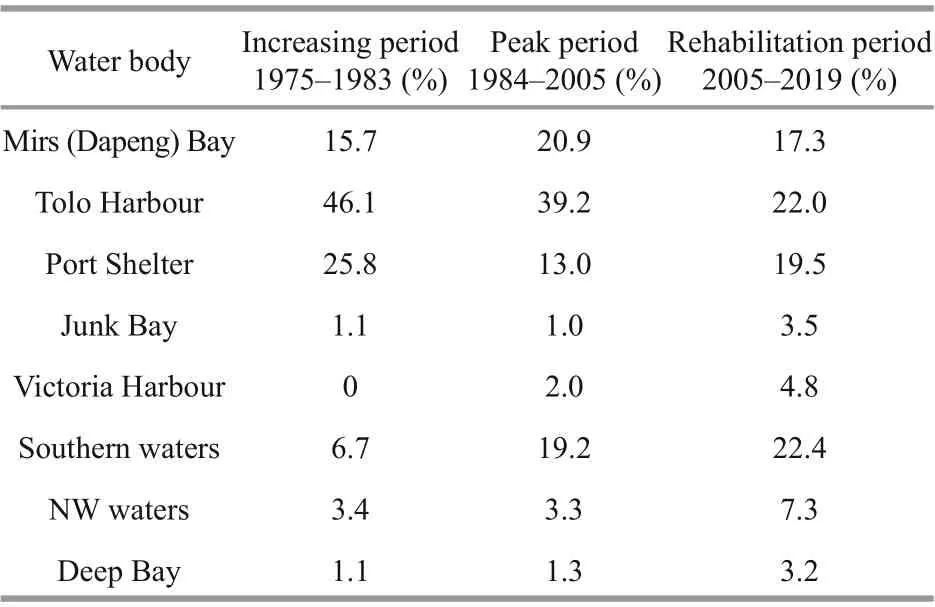
Table 3 Percentage distribution of HAB incidents in various waters of Hong Kong with respect to the three diff erent periods of HAB development
In the southern and northwestern waters of Hong Kong, the levels of Ammonia-N, Nitrate-N and TIN are relatively high (Table 2). These waters are geographically aff ected by the unlimited supplies of nutrients discharged from the Zhujiang River which facilitate and support harmful algae growth. While legislative and technological control of sewage and industrial discharges in Guangdong Province is very stringent now, widespread distribution of organic nutrients particularly nitrogen-based pollutants in Zhujiang River Delta is attributed to the non-pointsourced pollution (Liu et al., 2000; Yung et al., 2001;Wu and Yin, 2016; EPD, 2006; Zhang et al., 1999).On the basis of the spatial distribution and increasing inf luences, HAB in Hong Kong is considered only part of the regional event which has a wider coverage and ecological inf luences.
Interestingly, it is noted from the marine water monitoring results of EPD that TIN levels in most of the waters of Hong Kong are on the increasing trend on the basis of statistical analyses taking into account of seasonal patterns and long term variations of water quality parameters for the past 35 years (1986–2020). As shown in Fig.4, in locations which are of increasing trend of Ammonia-N and TIN, the levels of ortho-phosphates are on decreasing trend. Hence,the N꞉P ratios are signif icantly aff ected. Relevant changes provide pools of usable data for in-depth study of the formation mechanism of HAB in relation to nutrient concentrations and elemental ratios. Yet,limited amount of research have been conducted on them so far.
As evident from Table 1, there is gradual change in dominant species of HAB in recent years. In the past, meso-plankton and micro-plankton which are of bigger cell size played the prominent roles. However,we discovered that for a number of HAB incidents in the past decade, small f lagellates and organisms besides dinof lagellates and diatoms often take over the dominance. Whether the changes in diversity spectrum is related to water quality and/or ecological competition, or other reasons, is controversial. It has provided insight for follow-up research anyway.Furthermore, little study on the zooplankton community in Hong Kong has been conducted. The ecological relation and interactions between HAB species and zooplankton shall be better understood in future in order to draw a more complete picture of formation mechanism and ecological consequences of algal bloom (Shen et al., 2022).
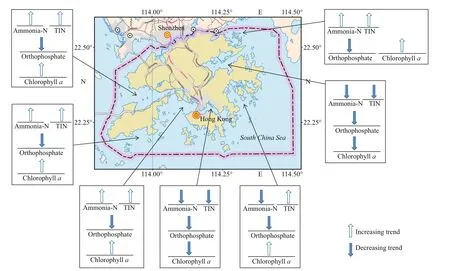
Fig.4 Long-term trends of ammonia-N, TIN, orthophosphate, and chlorophyll a with particular references to historical development of HAB in Hong Kong
4.2 Climate change and HAB
Whether HAB in Hong Kong is due to climatic phenomenon such as the El Niño has long been debated. The event ofGymnodiniumsp. blooms in 1997–1998 was considered closely relevant by some researchers (Wu, 1988, Lu and Hodgkiss,2004; Yin, 2003; Yin et al., 2000). Some researchers used the time-series of satellite images to track the development of the harmful algal bloom and concluded that they were related to movement of currents and the specif ic oceanographic conditions(Anderson et al, 1999). Remote sensing images of chlorophyllafrom SeaWiFS (sea-viewing wide f ield of view sensor) also affi rmed that the entire event coincided with the dramatic change in oceanographic conditions of the South China Sea of that year. It appears that increasing attention has been placed on studying the inf luences of weather, and related climate changes due to global greenhouse eff ects relates to the formation, aggregation and dissipation of HAB. Unfortunately, relevant researches have not been followed up closely after the events in 1997–1998. Anyway, the use of satellite SST images, and big-data theories and principles, is a non-stop trend of in-depth study of HAB in contemporary world.For example, the Research Grant Council of Hong Kong had generously supported a research project of the Open University of Hong Kong in 2016–2019 for development of prototype for early-warning and forecast of HAB.
Figure 5 shows the historical record of El Niño years vs. the red tide incident record in Hong Kong waters (Information of the f igure abstracted from Australian Bureau of Meteorology and United States Climate Prediction Center by the Wikipedia—online resources on El Niño). Interestingly, some years, including but not limited to 1975, 1976,1987–1988, 1991, 1994–1995, 1997–1998, 2004,2006–2007, 2018–2019 coincided with the years of high occurrence of red tide incidents in Hong Kong.El Niño events are thought to have been occurring for thousands of years. However, it is thought that there have been at least 30 El Niño events since 1900, with the 1982–1983, 1997–1998, and 2014–2016 events among the strongest on record. It is known that this anomaly happens at oscillating pattern with intervals of two to seven years, and lasts nine months to two years. The average period length is f ive years. When this warming occurs for seven to nine months, it is classif ied as El Niño “conditions”; when its duration is longer, it is classif ied as an El Niño “episode”.During strong El Niño episodes, a secondary peak in sea surface temperature across the far eastern equatorial Pacif ic Ocean sometimes follows the initial peak. While Hong Kong is located in the subtropical environment by the coast of South China Sea which is part of the western Pacif ic Ocean, whether red tide in Hong Kong is associated with the climatic phenomena is still controversial. Nevertheless, we f ind at least the oscillation pattern of El Niño occurrence closely matches with the periodical peaks of HAB occurrence happened in the history of Hong Kong.
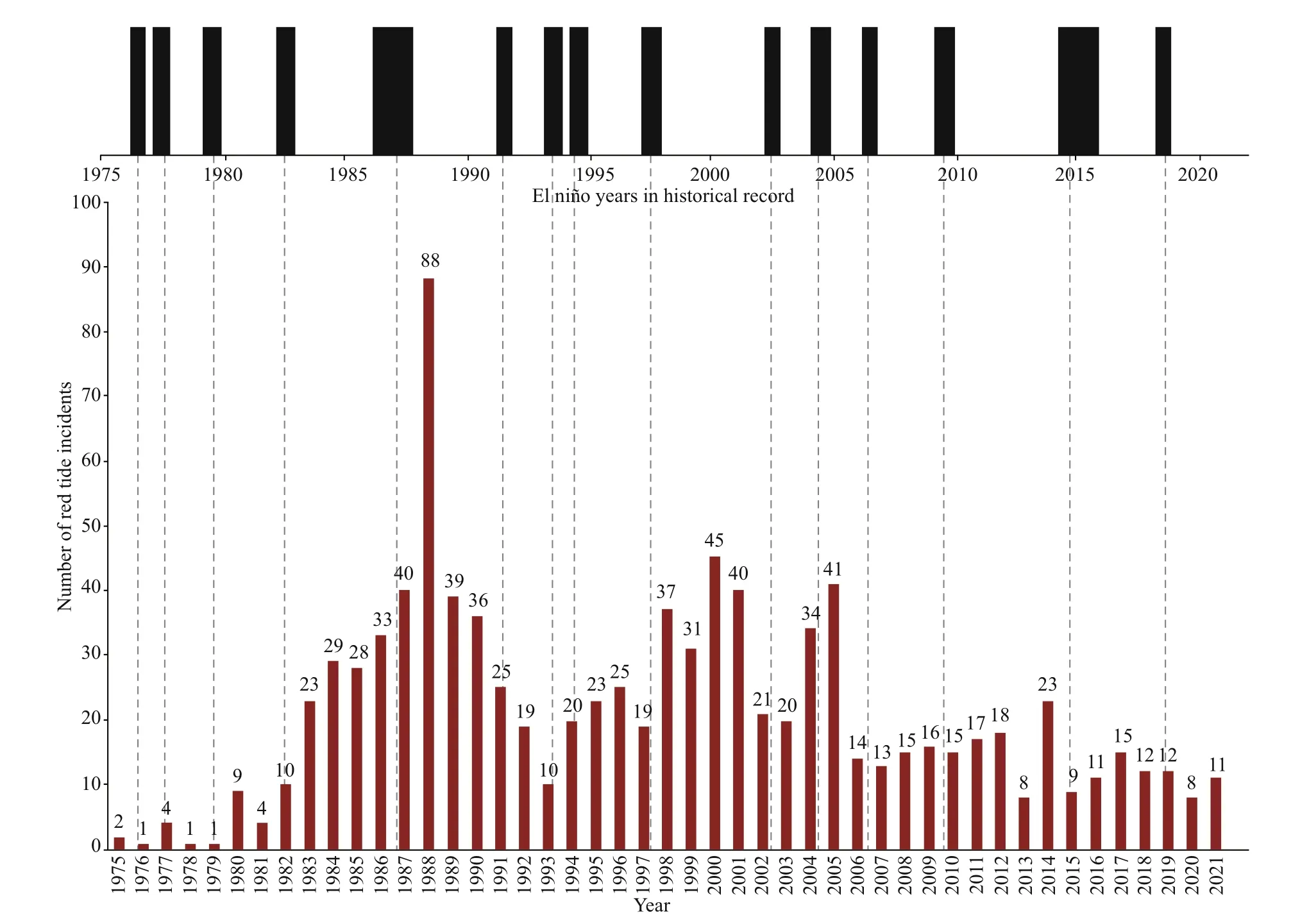
Fig.5 The historical record of El Niño years vs. the red tide incident record in Hong Kong waters
In the past 40 years, red tide ofNoctilucascintillanshas regularly aff ected the coastal waters of Hong Kong and the South China coast in late winter to mid spring. While HABs ofNoctilucascintillanswas shown closely relevant to oceanic situations, as discussed above, further study on the regional and climatic inf luences on its occurrence is an interesting topic for further research. Anyway, the occurrence ofNoctilucascintillansred tide has become more and more attractive to mass media and the general public.It is signif icant for conducting further research on HAB to enhance control and management as well as elucidating the inf luences of global climate change on environmental sustainability.
Input and output of essential nutrients (e.g., N,P, and Si), and their capabilities of supporting the growth and yield of harmful algae, is closely relevant to human activities as well as the hydrology and oceanographic conditions in water bodies. While the inf luences of global climate change to contemporary world should not be overlooked, it is important to enrich the database and the computing system for improvement of early warning and interpreting the trend of HAB.
4.3 Future research
Further research on the toxicity and toxicology of HAB is equally important for eff ective management and control. For example, a team of local researchers had conducted research on the acute f ish toxicity ofKareniamikimotoiandKareniapapilionaceaby the use ofOryziasmelastigma(Marine Medaka) as test subject (Kwok et al., 2016). This test concluded that the f ish kills happened in Zhujiang River estuary in 2016 should not attribute to the common environmental factors (e.g., drastic change of pH or dissolved oxygen). Virus contamination is not a cause lead to relevant f ish kill neither. Although were found in the seawater samples from four sampling points, their cell concentration were not high enough to reach a blooming level. However, sudden and drastic temperature change may be related to the toxin production mechanism.For further investigation by means of monocultures ofKareniamikimotoiandKareniapapilionaceain laboratory, together with f ield experiment and practice, are recommended. With regard to study of benthic micro-algae, it is of equal importance because they may cause ciguatoxins problems. For example,the appearance ofGambierdiscustoxicusin Junk Bay may have potential harms to f isheries, aquaculture and the seafood industry (Lu and Hodgkiss, 1999b, 2004).Further collaboration with academics and researchers in Chinese mainland is highly recommended with regard to benthos and benthic micro-algae, and the biological properties of resting cells of dinof lagellates.Such information is essential but rarely founded for HAB research in Hong Kong.
5 CONCLUSION
After reviewing the government documents,monitoring reports and published or orally presented papers related to HAB in Hong Kong, it is concluded that red tide (which is a term still commonly used by government offi cers and the general public of Hong Kong) happened in the past 47 years experienced three diff erent periods of change, namely the Increasing Period, the Peak Period and the Eco-rehabilitation Period. While local pollution sources have been under controlled, the inf luences of regional environmental impacts could not be overlooked nowadays. There are both spatial change and diversity change for HAB in Hong Kong in the past decade. While incidents ofNoctilucascintillansstill regularly occurred in the early months of a year, blooms of small f lagellates have obtained increased weight and both the aff ected areas and the duration of blooming are changing.Further research on the long term impacts of variation of N꞉P꞉Si, the use of satellite imaging and big-data,study of benthic species of toxicity, interrelation with zooplankton, resting cysts and individual organisms of potential harms are recommended for enhancing control and management.
6 DATA AVAILABILITY STATEMENT
This is a reviewed paper that all data generated and/or analyzed during this study are excerpted from published articles and digested by the author with fresh look. The sources of data were properly cited and listed out as far as possible in the list of References.
7 ACKNOWLEDGMENT
The author would like to thank the Department of Agriculture, Fisheries and Conservation and Department of Environmental Protection of Hong Kong Special Administrative Region, China, for allowance to re-analysis the data available from their offi cial websites and published annual reports/book.Their helpful supports are deeply appreciated.
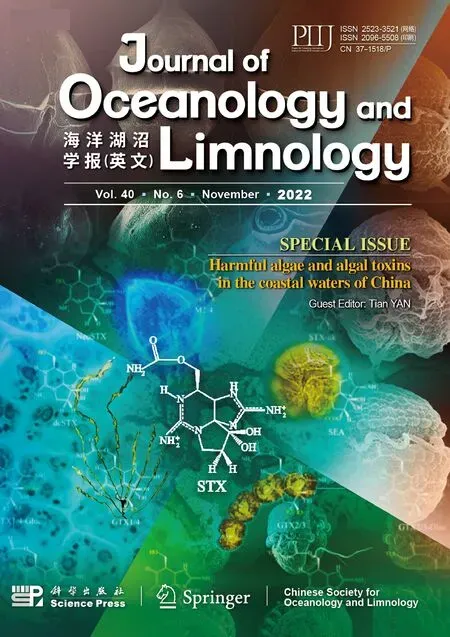 Journal of Oceanology and Limnology2022年6期
Journal of Oceanology and Limnology2022年6期
- Journal of Oceanology and Limnology的其它文章
- Information standardization for typical toxic and harmful algae in China’s coastal waters—a case study of Karenia mikimotoi*
- Biochemical composition of the brown tide causative species Aureococcus anophageff erens cultivated in diff erent nitrogen sources*
- Identif ication of paralytic shellf ish toxin-producing microalgae using machine learning and deep learning methods*
- Screening for lipophilic marine toxins and their potential producers in coastal waters of Weihai in autumn, 2020*
- First observation of domoic acid and its isomers in shellf ish samples from Shandong Province, China*
- Spatial variation of lipophilic marine algal toxins and its relationship with physicochemical parameters in spring in Laizhou Bay, China*
